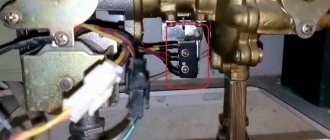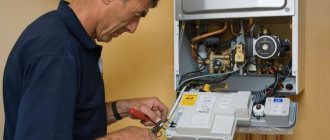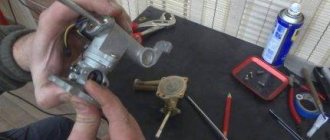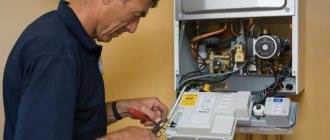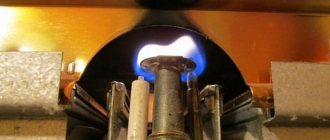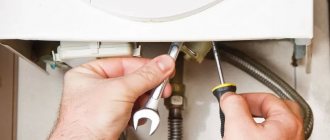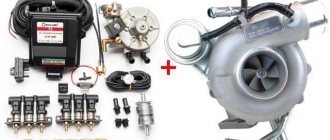Malfunctions in a gas water heater always occur at the wrong time, because they deprive you of your usual comfort. If the device begins to malfunction, it is worth finding out the reason; sometimes you can fix it yourself and do without calling a specialist. Let's figure out why the gas water heater goes out, what malfunctions lead to this, and what can be done in each situation.
Source rodnik.in.ua
About the working principle
You can only understand why the device does not work correctly if you understand how it works. A gas water heater is designed to heat water, but, unlike a boiler, it does not need a storage tank. It is a flow-type device: water moves inside, heating up as it moves; The heat source is a gas burner.
The column has an open or closed combustion chamber. A device with an open chamber works due to natural ventilation: it takes air from the room, combustion products are removed through the chimney (ventilation). In dispensers with a closed chamber (turbocharged), thrust is created forcibly using a fan.
The device is connected to the water supply and gas mains. The reasons why a geyser goes out are often related to the operation of its components. Technically, the column consists of the following components:
- Gas-burner.
- Heat exchanger. It is located above the burner and looks like a pipe twisted in a spiral (coil); This is where the water is heated.
Source dartshouse.ru
- Ignition. Older models used matches. In modern devices, a spark to ignite the burner is produced using a piezoelectric element. There are devices that run on batteries, a home electrical network, or a hydrogenerator (a turbine that starts working from the flow of water).
- Water-gas unit. Triggers when the tap opens. Water circulates in the column and presses on the membrane. The membrane activates the gas valve, which allows gas to enter the burner. The valve is equipped with a combustion intensity regulator. The mechanical water unit is also equipped with a safety valve.
- Security automation. This includes, for example, an ionization sensor; it monitors the presence of a flame. When a problem occurs, it closes the solenoid valve and the heating stops.
Specific problems for individual models
Even speakers from well-known companies can break down over time for a variety of reasons. During operation, device owners noticed breakdowns that most often occur with specific models.
Junkers Bosch thermocouple problems
For example, the weak point of the Junkers WR 13-P device manufactured by Bosch is the thermocouple.
Two to three years after the start of operation, it stops responding normally to heat from the pilot burner. As a result, the igniter flame constantly fades, and over time it will simply stop lighting normally.
Sometimes carefully cleaning the thermocouple with fine sandpaper helps, but when this method no longer brings the desired effect, the element will have to be replaced.
In some models of geysers, the thermocouple breaks down over time, which is easy to replace with a new element
Displacement of the igniter tube, which in such models is not secured too tightly, can also lead to similar problems. The tube can be moved accidentally, even just by touching it with a match during ignition. There is a gap between the gas tube nozzle and the burner through which air flows.
When displaced, this gap decreases, and the air required for normal combustion becomes insufficient. The flame does not reach the thermocouple, it does not heat up, and gas does not flow to the main burner. If you restore the normal position of the tube, the column will work properly again.
Practical recommendations for cleaning and eliminating breakdowns of the JUNKERS column:
Oxidation of contacts on Vector speakers
For Vector speakers, a typical problem is oxidation of the contacts in the power supply. If this is the case, then replacing dead batteries with new elements will not give the desired result; a spark will not appear until the contacts are cleaned. Sometimes in such columns the microswitch rod on the water valve becomes sour.
If the column hisses or whistles a little during operation, the fastenings of the coil tubes may be loose, you need to check them and solder them
After cleaning, normal operation of the device is usually restored. If a characteristic whistle appears soon after turning on the column, you need to check the condition of the gas outlet tube connections; they may need to be resealed.
Problems with the rod in Neva models
In Neva brand dispensers, sometimes the rod jams in the gas valve. As a result, this element stops working normally.
To eliminate such a malfunction, you need to remove and disassemble the water-gas unit, and then move the rod with a regular screwdriver. If the part cannot be mechanically affected, the element should be completely replaced.
This video demonstrates troubleshooting for a NEVA speaker:
Automation on guard
Many reasons why a gas water heater turns off during operation are related to the activation of the safety automatics. When failures occur, external or in other components, the fuel supply is automatically stopped. The thermal fuse, flame and draft sensors are responsible for the safe operation of the unit.
Source strojdvor.ru
Thermal fuse trips
This happens when overheating occurs: the speaker starts working normally, but turns off after a few minutes. The following reasons for the triggering are possible:
- Scale has formed in the heat exchanger, causing the volume of water to decrease and the coil to overheat. The reason is visible to the naked eye: with good pressure of cold water, hot water flows out in a thin stream, and the flame turns yellow. To combat scale, special compounds are used, and the heat exchanger is removed and cleaned.
- Hot water mixes with cold. This reduces the consumption of water heated by the column, which causes overheating of the heat exchanger. When the gas water heater goes out in such a situation, it is enough to change the pressure or adjust the dosage of the water supply (at the water heater).
- The strainer is clogged. It is installed on the water pipe at the entrance to the device. The consequences of its clogging are similar: the water flow drops, causing overheating and shutdown. The solution is to clean or replace the filter.
Source ytimg.com
Flame sensor triggered
The automation is activated and blocks the gas supply as soon as the burner goes out. If the external gas valve is open, the operation occurs for the following reasons:
- Strong gust of wind. The air in the chimney began to move in the opposite direction.
- Due to a strong draft, the flame breaks off, as evidenced by a whistle from the gas burner nozzle. If separation occurs regularly, it is worth adjusting the gas pressure with the burner screw. Sometimes the cause of separation is the installation of the wrong injector and it needs to be replaced.
Source prom.st
How to find a fault due to which the column does not light up?
First, rule out external causes: check the functionality of the pipelines, the availability of power, and the correct connection.
Then test it for the main features. For convenience, I put them in a table. Use it as a cheat sheet.
| What's happening? | Cause | What to do? |
| Unusual sounds, claps | Detonation of the gas-air mixture, wear of the solenoid valve, violation of the spark plug insulation | Insulate, replace |
| Turns off after 1-2 minutes | The protective relay is activated | Open a window or window |
| Doesn't respond to ignition | Poor traction | Clean the ventilation duct |
| Turning off the device immediately after startup | Carbon deposits have formed on the ignition element | Clean |
| Thermal protection sensors are triggered | Scale on the walls of the heat exchanger | Dismantle the unit, disassemble, wash |
| Weak heating power, change in flame color | The unit is clogged, soot appears underneath it | Preventative cleaning |
| Burner flame is weak | Blockage in the air supply channel | Cleaning the igniter |
Remember: heating of the liquid in the columns does not occur instantly. This requires 2-3 minutes.
Traction sensor activation
If the gas heater goes out during operation, the following situations may be the cause:
- There is no normal draft in the chimney. In order for combustion products to escape outside, the chimney must be cleaned regularly.
- If the chimney is clean, draft may be disrupted for other reasons. For example, when the house does not have supply valves, the draft may be disrupted due to double-glazed windows. In this case, the chimney cannot cope with maintaining sufficient air circulation even with periodic ventilation. The situation will be improved by installing supply valves.
- There is powerful ventilation in the room, and combustion products are removed through it. To resume the gas supply, just turn off or reduce the hood power.
Source oboiman.ru
Other causes of problems
When the wick in a gas water heater goes out during operation, the cause may be low pressure in the gas or water supply. The problem can occur in those models where the spark is generated using a water turbine. Then intervention in the operation of the unit is not required. Failure of work is possible for the following reasons:
- The membrane has lost its elasticity, and the column does not work in any position of the tap. The defective membrane is replaced with a new one.
- If the piezoelectric element is powered by batteries, it is important to replace them regularly, or use rechargeable batteries (they hold a charge longer).
- If you hear a popping sound when igniting, and the flame has a yellowish tint, the igniter is clogged and needs to be cleaned.
- Often the speaker goes out only when the shower is turned on. This suggests that at the moment of switching on, the water flow decreases. The cause could be a clogged mesh filter in the shower head, a clogged shower head, or a kinked rubber pipe inside the hose.
Source prouteplenie.com
About troubleshooting a geyser in the following video:
Conclusions and useful video on the topic
Finding the cause and ways to eliminate the problem of speaker attenuation can be found here:
Column attenuation is a symptom of an internal malfunction or violation of the operating conditions of the device. You need to correctly find out the cause of the problem, after which a significant part of the described breakdowns can be eliminated yourself. But to solve complex problems you will have to contact a service center.
Do you have any questions when searching for the cause of speaker attenuation? Ask them under this article - our experts and site visitors will try to help you.
Or maybe you want to tell other users about the problems that arose with your speaker during operation, and how they were successfully resolved? Share your experience and leave recommendations in the block below.
Briefly about the main thing
When a geyser refuses to work correctly, it is important to understand the reasons, because in many cases the malfunction can be easily fixed on your own. The reasons may be external: low pressure in the water supply, draft, backdraft in the chimney. Internal problems depend on the design of the gas water heater; sometimes the intervention of a specialist is necessary to eliminate them.
In order to encounter such troubles as little as possible, I advise you not to forget about the simple rules for operating geysers. It is important to regularly (at least once a year) clean the units from soot and scale, regularly change batteries, and check the chimney. It is also important not to disturb the air circulation in the room.
Question
Write in the comments what you think - is network water filtration necessary if the column uses a silicone membrane?
When to turn on the column
- Columns with a constantly burning wick - ignition is performed at the beginning of the day. Most consumers light the wick in the morning and leave it running throughout the day. After ignition, the column is completely ready for use. The first switching occurs with the opening of the hot water tap.
- Columns operating in automatic mode (without a wick) turn on independently after opening the DHW tap. Classic models refuse to work if there is no pressure in the pipeline. In modern water heaters, they turn on at low water pressure (0.3 atm).
